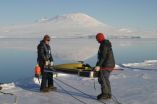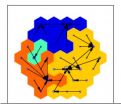Converting 2-D photo into 3-D face for security applications and forensics
2011-01-20
(Press-News.org) It is possible to construct a three-dimensional, 3D, face from flat 2D images, according to research published in the International Journal of Biometrics this month. The discovery could be used for biometrics in security applications or in forensic investigations.
Xin Guan and Hanqi Zhuang of Florida Atlantic University on Boca Raton explain how Biometrics, the technology of performing personal identification or authentication via an individual's physical attributes, is becoming an increasingly viable solution for identity management, information protection and homeland security. The researchers have now developed a computer algorithm that can analyze the viewing angle and illumination of a face in an image and generate a 3D view of the face based on the results.
The team points out that while our faces are all different they share so many characteristics that it is difficult for current computer technology to uniquely identify an individual from a flat, 2D image. However, a processed 2D image that yields a 3D image of the face would give a unique perspective.
A 3D image of a person's face might be used in biometrics alongside or instead of fingerprint, iris, face, voice and DNA, recognition techniques for so-called identity management and in security, coupled with smart cards and passwords computer recognition of a real face based on a 3D version of known personnel in a security database could be used to reduce false identification. The same technique might also be applied to analysis of security footage from closed-circuit television cameras (CCTV) in crime investigation or in searching for missing persons. Ultimately, the same technology might also be adapted by the entertainment industry where 2D images of famous people from the past might be rendered in 3D and so allow a face to be animated
INFORMATION:
"A method of creating 3-D face images from2-D photos for face recognition" in Int. J. Biometrics, 2011, 3, 40-55
END
ELSE PRESS RELEASES FROM THIS DATE:
2011-01-20
LA JOLLA, CA – A team of scientists at The Scripps Research Institute and the University of Virginia has determined the structure of the protein package that delivers the genetic material of the human immunodeficiency virus (HIV) to human cells.
The work is the culmination of studies carried out over the last decade looking at different portions of the cone-shaped container, or the capsid. The final piece of the puzzle, described in an article published in Nature on January 20, 2011, details the structure of the two ends of the cone.
"This paper is a real milestone ...
2011-01-20
PORTLAND, Ore. – According to research conducted at the Oregon National Primate Research Center at Oregon Health & Science University, the commonly held belief that oral contraceptives cause weight gain appears to be false. The results of the study are published online and will appear in next month's edition of the journal Human Reproduction.
"A simple Google search will reveal that contraceptives and the possibility that they may cause weight gain is a very highly debated topic," said Alison Edelman, M.D., a physician and researcher in the Department of Obstetrics ...
2011-01-20
With mortgage loan defaults on the rise yet again, two mortgage researchers are proposing a new type of mortgage contract that automatically resets the balance and the monthly payment based on the mortgaged home's market value.
Brent Ambrose, Smeal Professor of Real Estate and director of the Institute for Real Estate Studies at the Penn State Smeal College of Business, and Richard Buttimer, a professor in the Belk College of Business at the University of North Carolina at Charlotte, call their new mortgage contract the "adjustable balance mortgage" and contend that it ...
2011-01-20
Researcher Walker Smith of the Virginia Institute of Marine Science, College of William and Mary, has been conducting shipboard studies of biological productivity in Antarctica's Ross Sea for the last three decades. This year he's letting underwater robots do some of the work.
Smith and graduate student Xiao Liu are using a two-year grant from the National Science Foundation to deploy and test a free-swimming underwater glider in the frigid waters of the Ross Sea near the U.S. McMurdo Research Station. The grant also funds efforts by fellow VIMS professor Marjorie Friedrichs ...
2011-01-20
Grand Rapids, Mich. (January 19, 2011) – In a collaborative project involving scientists from three continents, researchers have identified a gene that is mutated in one in three patients with the most common form of renal cancer. The gene – called PBRM1 – was found to be mutated in 88 cases out of 257 clear cell renal cell carcinomas (ccRCC) analysed, making it the most prevalent to be identified in renal cancer in 20 years.
The identification of a frequently mutated gene provides new insights into the biology of the disease, which will be critical in the continued effort ...
2011-01-20
The instability of large, complex societies is a predictable phenomenon, according to a new mathematical model that explores the emergence of early human societies via warfare. Capturing hundreds of years of human history, the model reveals the dynamical nature of societies, which can be difficult to uncover in archaeological data.
The research, led Sergey Gavrilets, associate director for scientific activities at the National Institute for Mathematical and Biological Synthesis and a professor at the University of Tennessee-Knoxville, is published in the first issue of ...
2011-01-20
Chapel Hill, NC – The National Cancer Institute estimates that more than 43,000 Americans were diagnosed with pancreatic cancer last year and more than 36,000 died from the disease. Despite advances in genetic science showing that the Ras oncogene is mutated in virtually all pancreatic cancers, scientists have been frustrated by the complexity of the signaling pathways in humans, which make it difficult to pinpoint potential therapeutic targets.
In a study published today in the Cell Press journal Developmental Cell, a team of researchers led by Channing Der, PhD, Distinguished ...
2011-01-20
LIVERMORE, Calif. – Using seawater and calcium to remove carbon dioxide (CO2) in a natural gas power plant's flue stream, and then pumping the resulting calcium bicarbonate in the sea, could be beneficial to the oceans' marine life.
Greg Rau, senior scientist with the Institute of Marine Sciences at UC Santa Cruz and who also works in the Carbon Management Program at Lawrence Livermore National Laboratory, conducted a series of lab-scale experiments to find out if a seawater/mineral carbonate (limestone) gas scrubber would remove enough CO2 to be effective, and whether ...
2011-01-20
Washington, DC — Recent legislative and regulatory actions make great strides toward establishing much needed incentives for pharmaceutical companies and others to develop and test more medications for pediatric rare diseases, including pediatric cancers, according to commentary by experts from Children's National Medical Center. The commentary appears in the January 19 issue of Science Translational Medicine.
"Pediatricians who treat children with serious and life-threatening diseases often find themselves face to face with the inadequacies of pediatric drug development," ...
2011-01-20
Ebola, a virus that causes deadly hemorrhagic fever in humans, has no known cure or vaccine. But a new study by University of Illinois at Chicago scientists has uncovered a family of small molecules which appear to bind to the virus's outer protein coat and may inhibit its entry into human cells.
The results are to be published in the Journal of Medicinal Chemistry and are now online.
Previous studies have shown that small molecules can interfere with the Ebola infection process, says Duncan Wardrop, associate professor of chemistry at UIC and corresponding author of ...
LAST 30 PRESS RELEASES:
[Press-News.org] Converting 2-D photo into 3-D face for security applications and forensics

